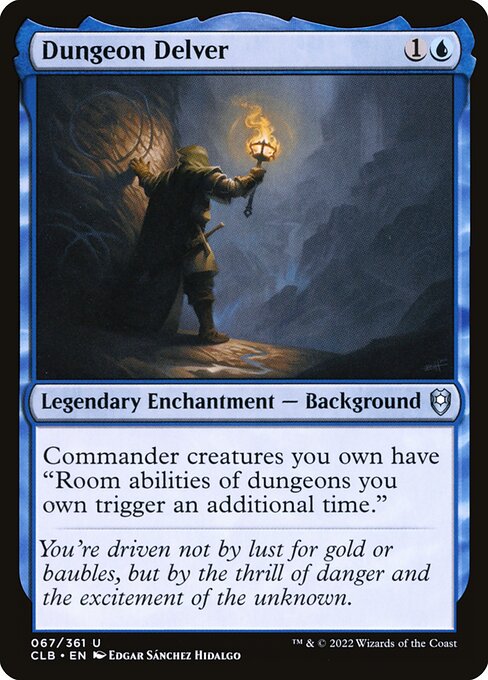
Image courtesy of Scryfall.com
Laughs, Islands, and Triggers: A Blue Card’s Guide to MTG’s Complexity
MTG’s rulebook sometimes reads like a tome written in runes, especially for newcomers who watch the table melt down over a single misread line. Yet humor has a keen eye for exposing the soft spots where complexity grows elbows-deep. When you tilt that lens toward a blue enchantment from Commander Legends: Battle for Baldur’s Gate, you get a playful, insightful critique that doesn’t insult players but invites them to reflect on how triggers, rooms, and dungeons weave together. 🧙♂️🔥 The card in focus today does more than look cool on the battlefield; it pokes at the way players track multiple layers of interaction in multiplayer formats, all while delivering a bit of flavor that makes your brain smile and your deck hum in harmony. 💎⚔️
Dungeon Delver: Blue, Bold, and a Bit Meta
From the CLB set, Dungeon Delver is a Legendary Enchantment — Background that costs {1}{U}. It’s blue through and through, a reminder that the most intricate MTG prayers are often whispered in the timing of a single spell. The card reads, in essence: “Commander creatures you own have ‘Room abilities of dungeons you own trigger an additional time.’” That means if your deck teems with dungeon-themed room abilities, your commander may reap extra benefits simply because you’re playing blue and stacking rooms. It’s a design that invites careful planning: how many dungeons do you own? Which rooms are worth duplicating? And how will your opponents react when your board suddenly doubles a sequence of dungeon effects? 🧭🎲
Flavor text: “You're driven not by a lust for gold or baubles, but by the thrill of danger and the excitement of the unknown.”
The flavor paints a picture of treasure-hungry explorers chasing the next doorway, while the mechanics reveal the intellectual treasure of MTG's complexity itself. Dungeon Delver’s artistry by Edgar Sánchez Hidalgo leans into a theme of exploration, with the dungeon’s corridors echoing the layered interactions that blue mages love to orchestrate. The rarity is uncommon, but its impact on a table can feel legendary when multiple dungeons line up with your commander’s needs. The set, Commander Legends: Battle for Baldur’s Gate, anchors the card in a crossover vibe between legendary command zones and D&D-inspired adventures. 🎨🧙♂️
What this card can teach about complexity—and its humor
- Trigger economies: The idea of “trigger an additional time” is both clever and anxiety-inducing. It rewards precise deck-building around dungeon rooms but also invites players to count effectively—an invitation to slow down and enjoy the math, rather than fear it. This is where humor shines: a card that asks you to track extra triggers becomes a meta joke about how deep the rabbit hole goes.
- Room-based synergy: Dungeons and their rooms are a mechanic that many players casually underestimate, but Dungeon Delver pushes you to consider the full ecosystem—how many rooms exist, which cards can influence them, and how many times you can push a sequence before the table lurches into a new tempo. The humor is in the contrast: a compact {U}-powered card that unlocks big-room potential. 🔥
- Commander dynamics: As a Background, Dungeon Delver sits beside your commander and makes a moral case for “theme over power” while still delivering practical, scalable advantage. It’s a gentle nudge toward more interactive design in multiplayer formats, where complexity isn’t just a hurdle but a shared puzzle. 💎
- Blue philosophy: The humor lands on blue’s affinity for control, planning, and counterplay. By doubling room triggers, you’re effectively guiding the tempo and narrative of the game—an elegant critique of how some players chase speed at the expense of a shared story. 🎲
Strategic takes: how to pair Dungeon Delver in your deck
Pulling off this enchantment’s full potential means embracing a balanced approach. Start with a blue commander who enjoys synergizing with enchantments and dungeon themes. Then pack a handful of dungeon cards whose room abilities are reliable and powerful enough to justify extra triggers. Since you’re chasing repeated room effects, consider ways to protect your engine—counterspells, bounce effects, and draw to keep your hand full while you assemble the dungeon chain. The design nudges you toward building a cohesive dungeon “network” rather than a scattered collection of odds-and-ends. And yes, your table will notice the humor when you suddenly chain-room-ability-turns back-to-back, drawing gasps and maybe a friendly groan. 🧙♂️🎲
For players who love tactile, tactile moments during long, rules-heavy sessions, a solid desk companion can feel as essential as a well-timed draw. This is where the cross-promotion sneaks in with a touch of whimsy: the product link at the bottom of this piece isn't just about merch—it celebrates the ritual of gathering around a table, debating a rule, and laughing at the glorious complexity of the game we adore. And yes, it’s a great excuse to upgrade your play space between matches. ⚔️💎
If you’re exploring how humor cards critique MTG’s complexity, Dungeon Delver is a perfect case study. It doesn't dumb down the game; it highlights how a well-timed interaction can turn a potential rules headache into a narrative beat that electrifies the table. And as you tune your dungeon strategy, you’ll discover that the most memorable MTG moments aren’t just the biggest plays—they’re the shared, laughter-filled debates that come with them. 🧙♂️🎨
To keep your setup ready for the next brainstorming session, check out this Gaming Mouse Pad 9x7 Neoprene with Stitched Edges — a dependable companion for long, rule-heavy evenings. It’s a practical, sturdy accessory that respects the rhythm of your play, just like a well-timed dungeon room trigger respects the rhythm of your turns.
Gaming Mouse Pad 9x7 Neoprene with Stitched EdgesMore from our network
- https://blog.digital-vault.xyz/blog/post/inferno-jet-and-the-weatherlight-saga-firebound-links/
- https://blog.digital-vault.xyz/blog/post/knights-of-dol-amroth-mana-curve-simulation-results/
- https://blog.digital-vault.xyz/blog/post/species-gorger-and-the-hidden-threads-of-mtg-lore/
- https://crypto-acolytes.xyz/blog/post/how-to-run-a-solana-validator-a-practical-guide/
- https://blog.digital-vault.xyz/blog/post/countering-sledding-otter-penguin-practical-mtg-tactics/